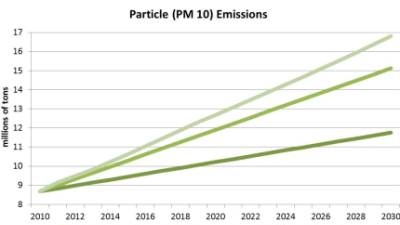Three Scenarios
The Business as Usual Scenario is based on economic performance for 2007-10 and recent IMF projections of GDP for 2011-15, with associated projections up to 2030. The model calculates the required investments to achieve the projected growth, along with the demands for different types of fuel. Some emission reduction happens under business as usual, reflecting recent policy initiatives to reduce the sulfur content of diesel in the transport sector, the use of compressed natural gas for public transport, emissions-limiting performance standards for passenger vehicles, and stricter enforcement of existing environmental laws.
The Green Growth Scenario targets a reduction in PM10 and other small emissions by 10 percent more than what could be achieved with business as usual by 2030. A tax on coal or PM10 is used to achieve a targeted emissions reduction, a shift to a greener fuel mix, and energy efficiency gains.
The Green Growth Plus Scenario incorporates a more aggressive 30 percent reduction in PM10 and other small particles in the air in 2030 over what could be achieved under business as usual. Here again, emissions reduction is attained through a tax on coal or PM10.
One important difference between the Green Growth and Green Growth Plus scenarios is that the latter assumes that, as the economy matures, the market realizes the economic benefits of cleaner and more efficient production. Gradually the environmental command-and-control “push” policies are replaced by market-driven “pull” policies to achieve cleaner and more efficient production. For example, coal technologies improve over time, with older, less efficient plants getting replaced, and advanced coal technologies become more competitive.
Results Under Each Scenario
Fossil fuel use, the primary cause of pollution, is expected to decrease under business as usual due to a declining share of coal in the overall energy demand (although coal would still dominate in 2030); greater emissions capture; and the shift to cleaner coal. Demand for refined oil products and electricity, however, will still increase considerably. As a result, the share of emissions from productive activities in total PM10 emissions is expected to double along with the impacts of the fast-increasing economic activities, such as manufacturing and construction, and transportation. The total PM10 emissions under business as usual are estimated to go up from 8.7 million tons in 2010 to 16.8 million tons in 2030.
Under the Green Growth Scenario, a 10% particulate emission reduction lowers GDP modestly. With a PM10 tax, conventional GDP is about $46 billion lower in 2030, representing a loss of 0.3 percent compared to business as usual. The impact on GDP is greater with a coal tax.
Under the Green Growth Plus Scenario, a 30% particulate emission reduction lowers GDP about $97 billion, or 0.7 percent. The scenario suggests that even a substantial reduction in emissions can be achieved without compromising much on GDP if supported by adequate least-cost policy measures. Again, the coal tax performs worse, with a GDP loss of 1.07 percent.
There are significant health benefits under both scenarios. The health damages from PM10 are reduced by $105 billion in the 30% case and by $24 billion with a 10% reduction. Under the Green Growth Plus Scenario, this more than compensates for the projected GDP loss.
Another important benefit would be a substantial reduction in CO2 emissions. The PM10 tax makes a bigger reduction in these emissions than the coal tax. Calculations show that even with a value per ton of CO2 of just $10, the reduction in CO2 for the 10% PM10 reduction case is worth $59 billion, little more than the loss of GDP. For the 30% case, the reduction is worth $83 billion, slightly less than the loss of GDP.
Conclusions
Environmental taxes could yield environmental benefits with minimal economic costs for India. The analysis shows that addressing "public bads" via selected policy instruments need not translate into large losses on GDP growth.
The model developed in this study can be used to evaluate the benefits of similar pollution-control policies and assist in designing and selecting appropriate targeted intervention policies (such as an SO2 tax, a CO2 tax, or emission trading schemes). Once the impact on air quality of a policy to reduce particulate emissions is estimated, the tools used to calculate the health damages associated with particulate emissions can also be used to compute the welfare impacts of reducing them.
The comparisons between the scenarios reveal that a low-carbon, resource-efficient greening of the economy should be possible at a very low cost in terms of GDP growth. A more aggressive low-carbon strategy (Green Growth Plus) comes at a slightly higher price tag for the economy while delivering greater benefits.
The extent to which GDP growth would be impacted under more severe cuts on polluting emissions can be determined by further study using the model. The modest GDP impacts indicated in this study depend on the availability and use of minimal-cost mitigation options (energy efficiency improvements, embodied technological improvements, improved daily operating practices of boilers). In evaluating the environment-growth tradeoffs, accordingly, a judgment must be made about the size and availability of such “low-hanging fruit” and appropriate incentives.

